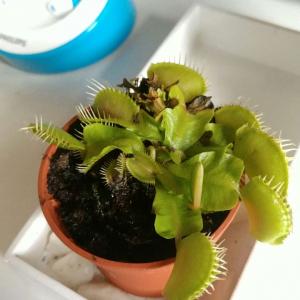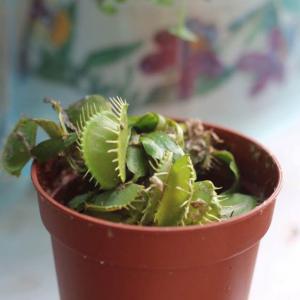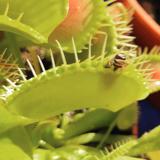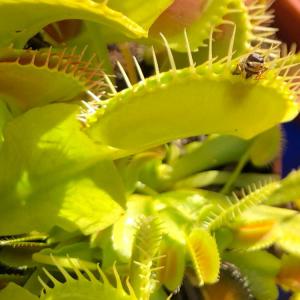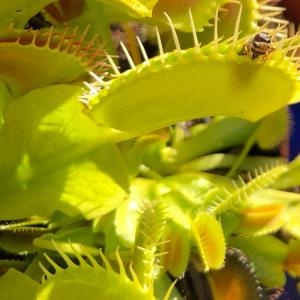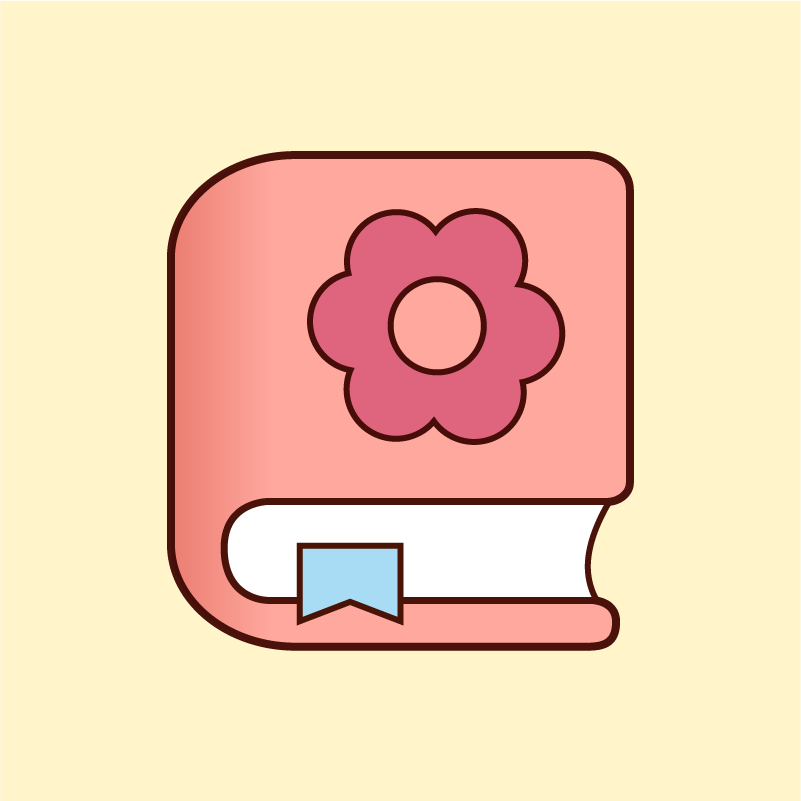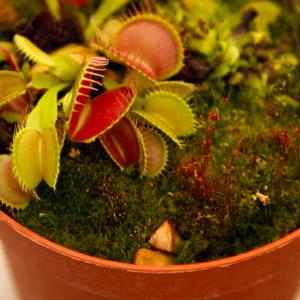文章
玲儿
2017年09月21日

ハエトリグサの基本情報
学名:Dionaea muscipula
和名:ハエトリグサ(蠅捕草) その他の名前:ハエトリソウ、ハエジゴク、ディオネア
科名 / 属名:モウセンゴケ科 / ハエトリグサ属(ディオネア属)
特徴
食虫植物と聞いて真っ先に思い浮かぶのがこのハエトリグサではないでしょうか。4枚から10数枚の葉をロゼット状につけ、細長い軍配形の葉柄の先に捕虫葉と呼ばれる二枚貝のような形の葉を広げます。捕虫葉の内側には片側に3本ずつ、感覚毛と呼ばれるセンサーが生えており、獲物がこのセンサーに短時間で2回以上触れると二枚貝状の葉が素早く閉じ、獲物を捕まえます。
触って葉を動かすのは楽しいものですが、それぞれの葉が開いたり閉じたりできるのはせいぜい4~5回です。むやみに触って動かすと株が疲れて弱ってしまうので注意しましょう。
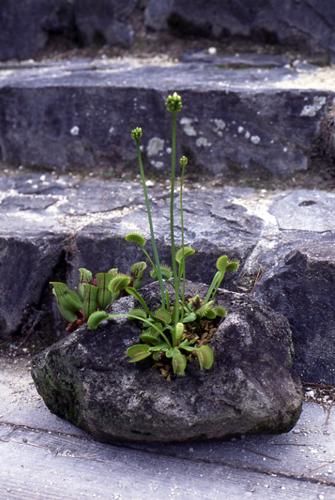
株の形状により2系統に大別され、葉が上向きに立ち上がって展開するものは「エレクタ系」、葉が地面に張りつくように平たく展開するものは「ロゼット系」と呼ばれます。そのほか、葉の縁の突起の形や葉の色合いに品種の差や個体差があり、好みの株を選んで育てる楽しみがあります。
一般的に、春から夏にかけて鉢植えとして流通します。

種類(原種、園芸品種)
‘赤い竜’
Dionaea muscipula ‘Akai Ryu’
株全体が赤く色づく品種。
‘デンテート・トラップス’
Dionaea muscipula ‘Dentate Traps’
捕虫葉の縁の突起が三角山状になる品種。
‘ソウトゥース’
Dionaea muscipula ‘Sawtooth’
「ノコギリの歯」の意味で、捕虫葉の縁の突起がノコギリの歯のような細かいギザギザになるもの。
学名:Dionaea muscipula
和名:ハエトリグサ(蠅捕草) その他の名前:ハエトリソウ、ハエジゴク、ディオネア
科名 / 属名:モウセンゴケ科 / ハエトリグサ属(ディオネア属)
特徴
食虫植物と聞いて真っ先に思い浮かぶのがこのハエトリグサではないでしょうか。4枚から10数枚の葉をロゼット状につけ、細長い軍配形の葉柄の先に捕虫葉と呼ばれる二枚貝のような形の葉を広げます。捕虫葉の内側には片側に3本ずつ、感覚毛と呼ばれるセンサーが生えており、獲物がこのセンサーに短時間で2回以上触れると二枚貝状の葉が素早く閉じ、獲物を捕まえます。
触って葉を動かすのは楽しいものですが、それぞれの葉が開いたり閉じたりできるのはせいぜい4~5回です。むやみに触って動かすと株が疲れて弱ってしまうので注意しましょう。

株の形状により2系統に大別され、葉が上向きに立ち上がって展開するものは「エレクタ系」、葉が地面に張りつくように平たく展開するものは「ロゼット系」と呼ばれます。そのほか、葉の縁の突起の形や葉の色合いに品種の差や個体差があり、好みの株を選んで育てる楽しみがあります。
一般的に、春から夏にかけて鉢植えとして流通します。

種類(原種、園芸品種)
‘赤い竜’
Dionaea muscipula ‘Akai Ryu’
株全体が赤く色づく品種。
‘デンテート・トラップス’
Dionaea muscipula ‘Dentate Traps’
捕虫葉の縁の突起が三角山状になる品種。
‘ソウトゥース’
Dionaea muscipula ‘Sawtooth’
「ノコギリの歯」の意味で、捕虫葉の縁の突起がノコギリの歯のような細かいギザギザになるもの。
0
0
文章
玲儿
2017年09月21日

ハエトリグサの基本情報
学名:Dionaea muscipula
和名:ハエトリグサ(蠅捕草) その他の名前:ハエトリソウ、ハエジゴク、ディオネア
科名 / 属名:モウセンゴケ科 / ハエトリグサ属(ディオネア属)
特徴
食虫植物と聞いて真っ先に思い浮かぶのがこのハエトリグサではないでしょうか。4枚から10数枚の葉をロゼット状につけ、細長い軍配形の葉柄の先に捕虫葉と呼ばれる二枚貝のような形の葉を広げます。捕虫葉の内側には片側に3本ずつ、感覚毛と呼ばれるセンサーが生えており、獲物がこのセンサーに短時間で2回以上触れると二枚貝状の葉が素早く閉じ、獲物を捕まえます。
触って葉を動かすのは楽しいものですが、それぞれの葉が開いたり閉じたりできるのはせいぜい4~5回です。むやみに触って動かすと株が疲れて弱ってしまうので注意しましょう。

株の形状により2系統に大別され、葉が上向きに立ち上がって展開するものは「エレクタ系」、葉が地面に張りつくように平たく展開するものは「ロゼット系」と呼ばれます。そのほか、葉の縁の突起の形や葉の色合いに品種の差や個体差があり、好みの株を選んで育てる楽しみがあります。
一般的に、春から夏にかけて鉢植えとして流通します。

種類(原種、園芸品種)
‘赤い竜’
Dionaea muscipula ‘Akai Ryu’
株全体が赤く色づく品種。
‘デンテート・トラップス’
Dionaea muscipula ‘Dentate Traps’
捕虫葉の縁の突起が三角山状になる品種。
‘ソウトゥース’
Dionaea muscipula ‘Sawtooth’
「ノコギリの歯」の意味で、捕虫葉の縁の突起がノコギリの歯のような細かいギザギザになるもの。
学名:Dionaea muscipula
和名:ハエトリグサ(蠅捕草) その他の名前:ハエトリソウ、ハエジゴク、ディオネア
科名 / 属名:モウセンゴケ科 / ハエトリグサ属(ディオネア属)
特徴
食虫植物と聞いて真っ先に思い浮かぶのがこのハエトリグサではないでしょうか。4枚から10数枚の葉をロゼット状につけ、細長い軍配形の葉柄の先に捕虫葉と呼ばれる二枚貝のような形の葉を広げます。捕虫葉の内側には片側に3本ずつ、感覚毛と呼ばれるセンサーが生えており、獲物がこのセンサーに短時間で2回以上触れると二枚貝状の葉が素早く閉じ、獲物を捕まえます。
触って葉を動かすのは楽しいものですが、それぞれの葉が開いたり閉じたりできるのはせいぜい4~5回です。むやみに触って動かすと株が疲れて弱ってしまうので注意しましょう。

株の形状により2系統に大別され、葉が上向きに立ち上がって展開するものは「エレクタ系」、葉が地面に張りつくように平たく展開するものは「ロゼット系」と呼ばれます。そのほか、葉の縁の突起の形や葉の色合いに品種の差や個体差があり、好みの株を選んで育てる楽しみがあります。
一般的に、春から夏にかけて鉢植えとして流通します。

種類(原種、園芸品種)
‘赤い竜’
Dionaea muscipula ‘Akai Ryu’
株全体が赤く色づく品種。
‘デンテート・トラップス’
Dionaea muscipula ‘Dentate Traps’
捕虫葉の縁の突起が三角山状になる品種。
‘ソウトゥース’
Dionaea muscipula ‘Sawtooth’
「ノコギリの歯」の意味で、捕虫葉の縁の突起がノコギリの歯のような細かいギザギザになるもの。
0
0
文章
Dummer. ゛☀
2017年08月21日

Carnivorous plants are endlessly fascinating. One such plant, the Venus flytrap, or Dionaea muscipula, is native to boggy areas of North and South Carolina. While the flytrap photosynthesizes and garners nutrients from the soil just as other plants, the fact is that boggy soil is less than nutritious. For this reason, the Venus flytrap has adapted to ingesting insects to round out its need for nutrients. If you are lucky enough to have one of these charmingly strange plants, you may have encountered some Venus flytrap problems – namely getting a Venus flytrap to close.
My Venus Flytrap Won’t Close
Probably the biggest reason your Venus flytrap does not snap shut is because it’s exhausted, sort of. The leaves of the flytrap have short, stiff cilia or trigger hairs. When something touches these hairs enough to bend them, the dual lobes of the leaves close, effectively trapping the “something” inside in less than a second.
There is a lifespan for these leaves, however. Ten to twelve times of snapping shut and they cease to function as trapping leaves and remain open, functioning as photosynthesizers. Chances are good that a store bought plant has already been jostled in transit and played with by any number of potential buyers and are just plain done. You will have to wait patiently for new traps to grow. It is also possible that the reason your Venus flytrap doesn’t snap shut is because it’s dying. Blackening leaves may signal this and are caused by bacteria, which may infect the trap if it hasn’t completely closed when feeding, as when an overly large bug is caught and it can’t shut tightly. A complete seal of the trap is needed to keep the digestive juices in and bacteria out. A dead plant will be brown-black, mushy, and have a rotting odor.
Getting a Venus Flytrap to Close
If you feed your Venus flytrap a dead insect, it will not struggle and signal the cilia to close. You have to manipulate the trap gently to simulate a live insect and allow the trap to snap shut. The trap then secretes digestive juices, dissolving the soft innards of the bug. After five to 12 days, the digestive process is completed, the trap opens and the exoskeleton is blown away or washed out with the rain. Getting your flytrap to close may be a matter of temperature regulation. Venus flytraps are sensitive to the cold which will cause the traps to close very slowly.
Keep in mind that the hairs on the traps or lamina have to be stimulated for the trap to shut. At least one hair must be touched twice or several hairs in rapid succession as when an insect is struggling. The plant can distinguish between a living insect and say, raindrops, and will not close for the latter. Lastly, like most plants, the Venus flytrap lies dormant during the fall through to the following spring. During this time period, the trap is in hibernation and has no need for additional nutrition; hence, the traps do not respond to stimulus. Overall green color in the leaves indicates the plant is simply resting and fasting and not dead.

My Venus Flytrap Won’t Close
Probably the biggest reason your Venus flytrap does not snap shut is because it’s exhausted, sort of. The leaves of the flytrap have short, stiff cilia or trigger hairs. When something touches these hairs enough to bend them, the dual lobes of the leaves close, effectively trapping the “something” inside in less than a second.
There is a lifespan for these leaves, however. Ten to twelve times of snapping shut and they cease to function as trapping leaves and remain open, functioning as photosynthesizers. Chances are good that a store bought plant has already been jostled in transit and played with by any number of potential buyers and are just plain done. You will have to wait patiently for new traps to grow. It is also possible that the reason your Venus flytrap doesn’t snap shut is because it’s dying. Blackening leaves may signal this and are caused by bacteria, which may infect the trap if it hasn’t completely closed when feeding, as when an overly large bug is caught and it can’t shut tightly. A complete seal of the trap is needed to keep the digestive juices in and bacteria out. A dead plant will be brown-black, mushy, and have a rotting odor.

Getting a Venus Flytrap to Close
If you feed your Venus flytrap a dead insect, it will not struggle and signal the cilia to close. You have to manipulate the trap gently to simulate a live insect and allow the trap to snap shut. The trap then secretes digestive juices, dissolving the soft innards of the bug. After five to 12 days, the digestive process is completed, the trap opens and the exoskeleton is blown away or washed out with the rain. Getting your flytrap to close may be a matter of temperature regulation. Venus flytraps are sensitive to the cold which will cause the traps to close very slowly.

Keep in mind that the hairs on the traps or lamina have to be stimulated for the trap to shut. At least one hair must be touched twice or several hairs in rapid succession as when an insect is struggling. The plant can distinguish between a living insect and say, raindrops, and will not close for the latter. Lastly, like most plants, the Venus flytrap lies dormant during the fall through to the following spring. During this time period, the trap is in hibernation and has no need for additional nutrition; hence, the traps do not respond to stimulus. Overall green color in the leaves indicates the plant is simply resting and fasting and not dead.
1
0
文章
Dummer. ゛☀
2017年08月21日

Carnivorous plants are fun to grow and fascinating to watch and learn about. The Venus fly trap (Dionaea muscipula) is a moisture loving plant that grows near marshes and bogs. The plants have been overharvested in their native habitat and are becoming rare. Native to only a few areas in North and South Carolina, Venus fly traps grow in nitrogen depleted soils. This is why they trap insects, which provide them with the necessary nitrogen. Venus fly trap care is relatively easy and makes a great family project.
How to Care for a Venus Fly Trap
The Venus fly trap needs slightly acidic moist soils. Grow a Venus fly trap in a peat moss and sand mixture, which will provide mild acidity and help hold water without keeping soils too soggy. The plant needs at least 60 percent humidity and day time temperatures of 70 to 75 F. (22-24 C.). Nighttime temperatures should not go below 55 F. (13 C.). The Venus fly trap is sensitive to chemicals and heavy mineral contents, so a distilled or bottled water is best. Keep water off the foliage by soaking the plant for an hour in a dish of water to moisten the soil. In order to make Venus fly trap care easier, make it a terrarium. An old aquarium makes a good housing for the plant if you cover it. This encourages humidity and moisture retention and you can allow insects to fly around inside for the plant to catch. Line the inside with TWO parts sphagnum moss and one part sand. The Venus fly trap can then be placed in an east- or west-facing window with high indirect lighting.
Venus fly trap is a rosette form with four to six leaves that are hinged and able to close. They are tinged a rosy pink on the edges and secrete an attractive nectar. The edges of the leaves have numerous fine sensitive cilia. When an insect touches the cilia the leaf closes and traps the insect. Special digestive juices disintegrate the insect and the plant feeds on the insects bodily fluid. Caring for a venus fly trap must ensure that it is exposed to areas where it can capture insects. Learn how to care for a Venus fly trap to help this disappearing species continue.
What to Feed a Venus Fly Trap Plant
The fly trap lives up to its name by using its clasping leaves to trap insects. Its diet is not only confined to flies and it will eat creeping insects such as ants, too. When you are caring for a Venus fly trap indoors, you need to assist them by capturing insects. Use tweezers and place the insect on an open leaf pad and tickle the little hairs on the edge until it closes. Some people try to water with beef bouillon or another protein but this can cause mold to form and is not recommended.

How to Care for a Venus Fly Trap
The Venus fly trap needs slightly acidic moist soils. Grow a Venus fly trap in a peat moss and sand mixture, which will provide mild acidity and help hold water without keeping soils too soggy. The plant needs at least 60 percent humidity and day time temperatures of 70 to 75 F. (22-24 C.). Nighttime temperatures should not go below 55 F. (13 C.). The Venus fly trap is sensitive to chemicals and heavy mineral contents, so a distilled or bottled water is best. Keep water off the foliage by soaking the plant for an hour in a dish of water to moisten the soil. In order to make Venus fly trap care easier, make it a terrarium. An old aquarium makes a good housing for the plant if you cover it. This encourages humidity and moisture retention and you can allow insects to fly around inside for the plant to catch. Line the inside with TWO parts sphagnum moss and one part sand. The Venus fly trap can then be placed in an east- or west-facing window with high indirect lighting.

Venus fly trap is a rosette form with four to six leaves that are hinged and able to close. They are tinged a rosy pink on the edges and secrete an attractive nectar. The edges of the leaves have numerous fine sensitive cilia. When an insect touches the cilia the leaf closes and traps the insect. Special digestive juices disintegrate the insect and the plant feeds on the insects bodily fluid. Caring for a venus fly trap must ensure that it is exposed to areas where it can capture insects. Learn how to care for a Venus fly trap to help this disappearing species continue.

What to Feed a Venus Fly Trap Plant
The fly trap lives up to its name by using its clasping leaves to trap insects. Its diet is not only confined to flies and it will eat creeping insects such as ants, too. When you are caring for a Venus fly trap indoors, you need to assist them by capturing insects. Use tweezers and place the insect on an open leaf pad and tickle the little hairs on the edge until it closes. Some people try to water with beef bouillon or another protein but this can cause mold to form and is not recommended.
0
1
成长记
domoatack
2017年02月20日

I Nuevo agregado un Venus atrapamoscas - Dionaea muscipula en mi jardín


1
0





